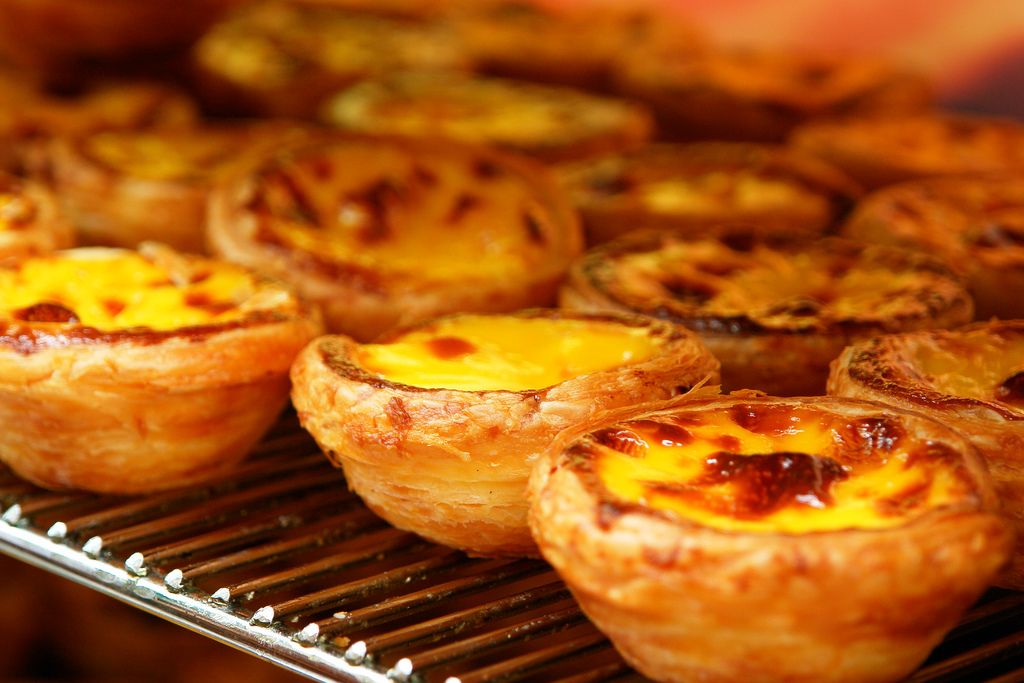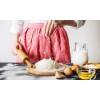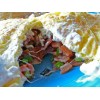A popular dessert, Egg Tart
The egg tart is a kind of custard tart found in Macau, Hong Kong, Mainland China, Taiwan, Argentina, Portugal, Brazil, Britain, and various Asian countries. The dish consists of an outer pastry crust and is filled with egg custard and baked.
History
The egg tart is believed to have its origins in the Chinese city of Guangzhou. The English custard tart and the Portuguese pastel de nata are European forerunners of the Chinese egg tart, which displays characteristics of both. From the pastel de nata, English styles of cooking came to influence the tart. Chefs from Guangzhou arrived in Hong Kong bringing in tart recipes since Guangzhou had heavy European influence as a major port. Taking reference from the recipes of the custard tart, the chefs in Guangzhou turned it into egg tarts by filling egg custards in the middle instead, a similar way to make simmered eggs with milk (炖蛋). However, as butter was very costly at that time, it was difficult for the chefs to make puff pastry for the tarts. Therefore, they may have used lard instead. During the 1920s, as there was tough competition between department stores in attracting customers, the chef of each department store would invent a new dim sum or dessert weekly as an attraction. In 1927, Zhenguang Restaurant was the first to introduce egg tarts, which was very popular and attracted other restaurants to follow suit.
Many Guangzhou chefs migrated to Hong Kong and brought recipes with them. Hong Kong received the pastel de nata egg tart from Macau which was a colony of Portugal and combined aspects of the Portuguese tart with their own. The modern egg tarts were first introduced in Hong Kong in the 1940s through cha chaan tengs which served foreign-influenced dishes. Hence, the modern egg tarts emerged.
Types
1. Butter type
Buttered egg tart skin is smooth and complete, like a potted biscuit, with a butter fragrance, similar to Pie Crust, which is commonly used in Western Points. It tastes like cookies, so it is also known as Cookie skin.
2. Crispy skin type
Crispy egg tart skin is a layer of thin crispy skin, similar to the Western pastry (Puff Pastry); but because of the use of lard, the taste is rougher than the butter crisp. In addition, because the tart skin is thicker, the filling quantity of crisp egg tart is less than that of the butter egg tart.
In addition to sugar and eggs as the mainstream egg tarts, there are also varieties of egg tarts mixed with other materials in the egg paste, such as fresh milk tarts, ginger juice tarts, egg tarts, chocolate tarts and bird's nest tarts.
3. Portuguese class
Portuguese butter tart, also known as Portuguese egg tower, Hong Kong and Macao called Portuguese tart, is a small butter pastry, its charred surface (caramel after excessive heating of sugar) is its characteristics. Legend has it that it was invented by the nuns of the Geronimo Monastery in Lisbon, Portugal, at the latest in the 18th century. Beginning in 1837, it was sold in the secular bakery, which was called the Bellintar because of its location in Belin, Lisbon.
The earliest Portuguese egg tart came from Andrew Stow, an Englishman. After eating Pasteis de Nata, a traditional snack in Belem near Lisbon in Portugal, he decided to add his own creativity to the traditional recipe. In 1989, he opened an Andrew's Cake Shop on Round Island, Macau Road, and created a popular Portuguese egg tart using lard, flour, water and eggs, as well as British pastry practices.
Although Portuguese Tartar was created by Andrew, its fame was bestowed by Andrew and his wife's marriage. In 1996, Andrew and his wife Margaret broke up.
Margaret left Andrew to start a new business, renamed the store that belonged to her own name "Margaret" and settled in Hong Kong and Taiwan, inadvertently whirlwind of Portuguese tart.
Authentic Margaret Portuguese egg tarts must be manufactured by hand: delicate and round tarts, golden eggs, and caramel ratio, which are checked by professional chefs, to reach the perfection that ordinary egg tarts can not achieve. The base of Margaret's egg tart on the table is just like the fresh croissant bread. It tastes soft and crisp. The filling is rich and the fragrance of milk eggs is very strong. Although the taste is layer by layer, it is sweet but not greasy.
Recipes
1. Hong Kong Style Egg Tarts
Ingredients
1 cup confectioners' sugar 3 cups all-purpose flour 1 cup butter
1 egg, beaten
1 dash vanilla extract
2/3 cup white sugar 1 1/2 cups water9 eggs, beaten 1 dash vanilla extract 1 cup evaporated milk
Directions
1). In a medium bowl, mix together the confectioners' sugar and flour. Mix in butter with a fork until it is in small crumbs. Stir in the egg and vanilla until the mixture forms a dough. The texture should be slightly moist. Add more butter if it is too dry, or more flour, if the dough seems greasy. Shape dough into 1 1/2 inch balls, and press the balls into tart molds so that it covers the bottom, and goes up higher than the sides. Use 2 fingers to shape the edge into an A shape.
2). Preheat the oven to 450 degrees F (230 degrees C). Combine the white sugar and water in a medium saucepan, and bring to a boil. Cook until the sugar is dissolved, remove from heat and cool to room temperature. Strain the eggs through a sieve, and whisk into the sugar mixture. Stir in the evaporated milk and vanilla. Strain the filling through a sieve, and fill the tart shells.
3). Bake for 15 to 20 minutes in the preheated oven, until golden brown, and the filling is puffed up a little bit.
2. Portuguese Egg Tarts
Ingredients
For the Puff Pastry:
1 1/2 sticks unsalted butter, softened
1 3/4 cups all-purpose flour, plus more for dusting
2/3 cup water
1/4 teaspoon kosher salt
For the Filling and Garnish:
1 cup granulated sugar
2/3 cup water
1 cinnamon stick
1 cup, plus 6 tablespoons, whole milk, divided
1/2 cup all-purpose flour
6 egg yolks
Ground cinnamon, for garnish
Directions
1). Make the puff pastry: In a small bowl, whisk the butter until it is the consistency of sour cream. In the bowl of a stand mixer fitted with the dough hook, combine the flour, water and salt. Mix on low speed, scraping the bowl down occasionally, until the mixture comes together and has a tacky consistency.
2). Transfer to a well-floured work surface and form into a 1-inch rectangle. Using a floured rolling pin, roll the dough into a 1/2-inch-thick rectangle, 10 inches long. Cover with plastic wrap and let it rest for 15 minutes.
3). Remove the plastic wrap and roll the dough into a 15-inch square, dusting with more flour as needed. Spread a third of the butter on the bottom half of the dough, leaving a 1-inch rim. Using a bench scraper, fold the top half of the dough over the butter. Press the edges to seal and pat the dough with the rolling pin. Roll the dough into another 15-inch square. Spread half of the remaining butter on the bottom half of the dough, leaving a 1-inch rim. Using the bench scraper, fold the top half of the dough over the butter. Press the edges to seal. Pat the dough with the rolling pin and rotate the dough so that the seam is facing you. Now, roll into an 18-inch square.
4). Spread the remaining butter all over the dough, leaving a 1-inch rim. Starting with the edge closest to you, roll the dough into a tight log. Wrap in plastic wrap and refrigerate until very firm, at least 2 hours, preferably overnight.
5). Make the filling: Preheat the oven to 500°. In a medium saucepan, combine the sugar, water and cinnamon stick over high heat. Bring to a boil and cook for 1 minute, then remove from the heat and let sit until ready to use.
6). On a lightly floured surface, trim the ends of the dough to make sure they're even, then cut the log into thirty 1/2-inch slices. Place each slice into the cavity of an egg tart mold or muffin tin, with the cut side of the spiral facing up. Use your thumb to press the center of the spiral into the bottom of the pan and continue pressing to evenly flatten the dough against the bottom and sides of the cavity, extending about 1?16 inch above the rim of the tart molds or 3/4 inch up the sides of the muffin tin. Repeat with the remaining dough. Refrigerate until firm, 10 minutes.
7). Meanwhile, in a small saucepan, heat 1 cup, plus 1 tablespoon, of the milk over medium heat until bubbles begin to form around the edges, 4 to 5 minutes. In a large bowl, whisk the flour with the remaining 5 tablespoons of milk. Continue whisking while adding the hot milk in a slow, steady stream. Discard the cinnamon stick from the sugar syrup and whisk the syrup into the milk mixture in a steady stream. Return to the saucepan and cook over low heat, whisking constantly, until thickened 10 to 12 minutes.
8). Add the yolks to the mixture and whisk until well combined, then strain through a fine-mesh sieve. Pour 1 1/2 tablespoons of the warm filling into each pastry shells.
9). Bake until the shells are golden brown and crisp, the custards are set, and the tops are blackened in spots, 15 to 20 minutes. Let cool in the pans on wire racks for 5 minutes. Then, remove the molds, transfer the tarts to the wire racks and sprinkle with cinnamon. Serve warm.
Related Articles
Search
Categories
Popular Posts






















Comments: 0
No comments